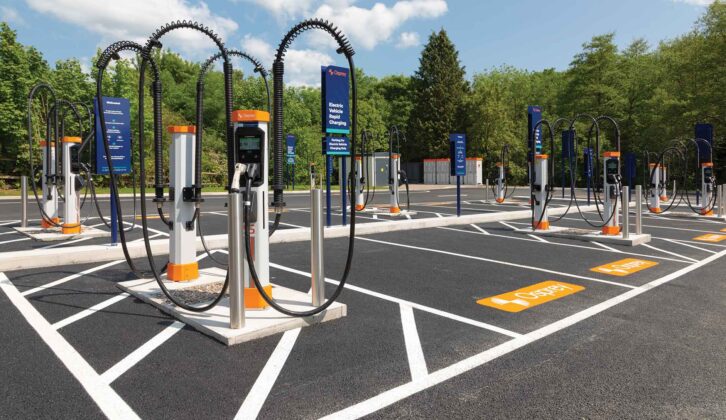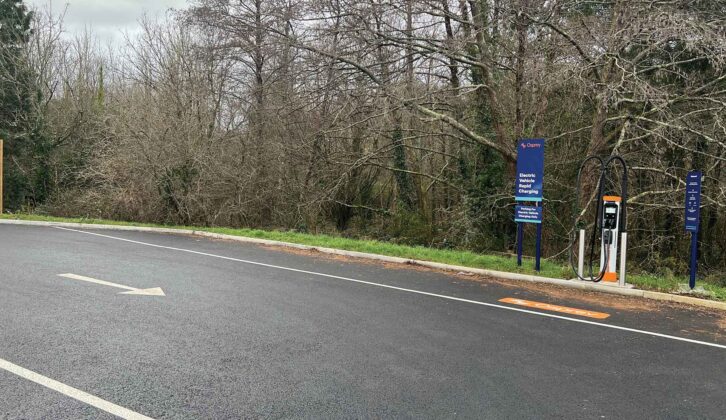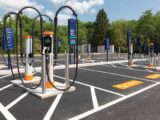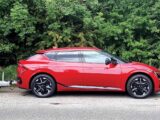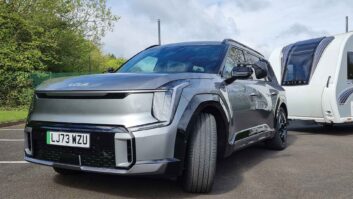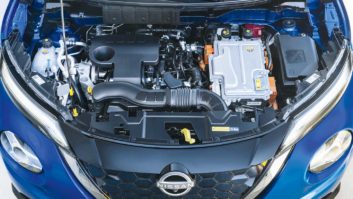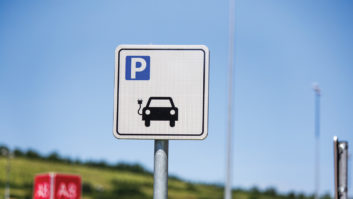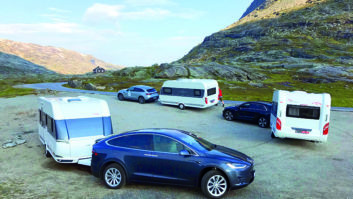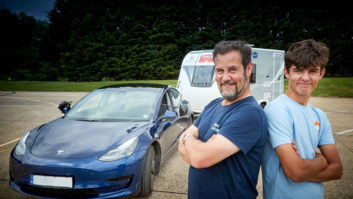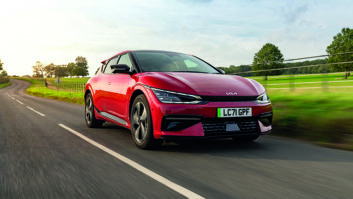Electric vehicles now account for one in five new cars sold in the UK. Believe it or not, that’s around four times as many EVs as diesels. These strong sales figures are largely driven by the company car market, with attractive tax incentives to encourage business drivers to switch to electric cars.
However, for caravanners, there can be reason to think twice about switching to even the best electric tow car.
After all, towing a caravan long distances with an electric car is more complicated and time-consuming than making lengthy journeys in an EV without a caravan.
If you are determined to switch to electric power, it can be done. You might have to change your approach to towing and plan carefully to make it work, though.
EV range while towing
All sorts of factors affect the range of an electric car. One thing that’s guaranteed to have a negative impact is the weight and aerodynamic drag of a caravan.
In my experience, the range of an electric car roughly halves while pulling a tourer. The Camping and Caravanning Club and What Car? reached a similar conclusion when they tested the range of several electric cars, comparing solo driving to the range while towing. The Tesla Model Y achieved a range of 262.5 miles in solo driving, dropping down to 112.5 miles while towing a 1600kg caravan.
Pulling a lighter caravan helps make each kilowatt go further. In my recent test of a Kia EV6, I achieved a range of roughly 140 miles towing a 1373kg tourer.
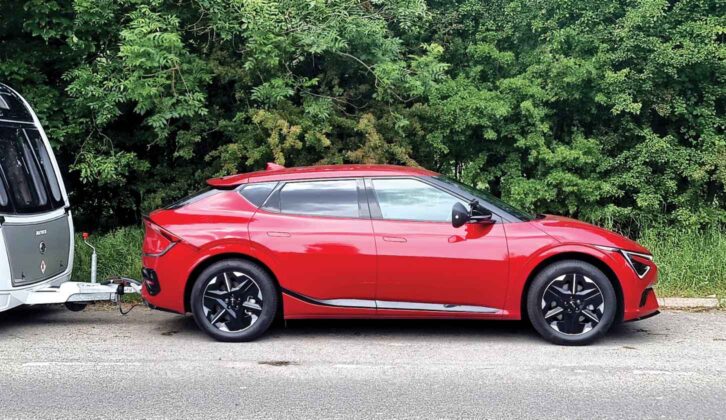
That might not seem like a long way, but it’s best practice to stop for a break from driving every couple of hours. The range of electric cars while towing wouldn’t be a huge barrier to towing with an EV if it were quick and convenient to recharge.
The trouble with charging
The difficulty is that most EV charging bays are designed for one vehicle. Very few bays are intended to be driven through, with room for a car and caravan (or trailer).
There are some notable exceptions. Osprey’s charging hub at Strawberry Fields Farm Shop just off the A38 near Buckfastleigh, in Devon, has two extra-long pull-through bays, suitable for caravanners to use with no need to unhitch.
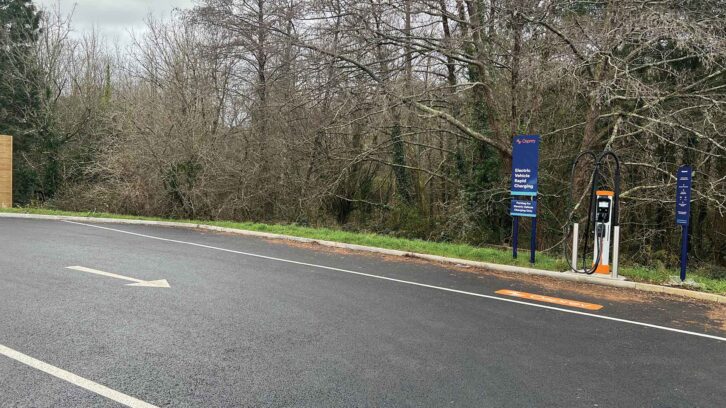
Instavolt has opened a huge charging hub near Winchester, in Hampshire, which also features drive-through bays that are suitable for cars and caravans.
At most of the charging hubs and motorway services, however, the van will need to be unhitched from the car. Then the car will have to be driven from the caravan parking spot to the electric vehicle chargers.
It’s worth having a look at the layout of motorway service stations on Google Maps when you are planning your route, to see where the chargers are, relative to the caravan parking.
In particular, make sure there’s no one-way system that will stop you reaching the chargers. If in doubt, call the services first and ask for clarification.
Charging speeds
Over the past few years, the number of so-called ‘ultra-rapid’ chargers has increased enormously. Provided your car is compatible with this style of charging (most modern EVs are), these are the best type to use if you want to be on your way quickly.
For example, the Instavolt chargers near Winchester are capable of charging at up to 160kW. That’s powerful enough to take compatible cars from a 10% to an 80% charge in around 20 minutes.
If you really need a 100% charge to complete your journey, you’ll have to be patient, because the rate of charging slows while squeezing in the last few kilowatts.
Be aware, too, that chargers don’t always deliver the stated maximum level of charge, so you should be prepared to wait longer. However, if you coincide recharging with a meal, you can be on your way again with the minimum of inconvenience.
Security while charging
Should you need to unhitch to charge, you will clearly want to make sure that your caravan remains safe and secure.
Ideally, you would leave one of your adult passengers with the caravan. Whether or not it is attended, fit the best caravan wheel clamp, hitch lock, or both, to minimise the chance of anyone making off with the caravan while the car is being charged.
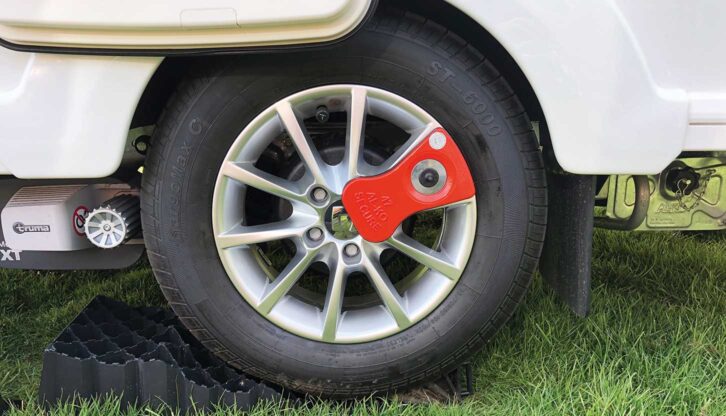
Your caravan insurance policy is likely to stipulate a minimum level of caravan security whenever your tourer is unhitched from the car. Even if you intend to keep the caravan in sight at all times, it’s always best to use appropriate security devices.
If you’re looking for a suitable wheel clamp, don’t miss our guide to “which Al-Ko wheel lock fits my caravan?”, to help you get the size best suited to your tourer.
Easier towing with an EV
For caravanners, the easiest way to reduce the hassle of recharging is to choose tour destinations within reach on a single charge.
Wherever you live, there will be amazing places to visit within 100 miles or so. Then you can either recharge on the pitch (many campsites will allow this provided you plug in via the caravan) or find a charger near where you stay.
For Londoners, the South Downs are easily within reach. Mancunians could visit the Peak or Lake District without needing to stop. From Cardiff, caravanners could tow to The Gower with charge to spare, while the Trossachs are comfortably reachable from Edinburgh.
If a radius of 100 miles is too limiting, try to pick a destination that can be reached with just one charging stop. Research your mid-journey charge thoroughly and have
a couple of back-up chargers in mind.
Changing your caravan
Small caravans with a lighter weight will have a smaller impact on the vehicle’s range than a heavy one. Athough not strictly a caravan, a folding camper such as an Opus will have a much smaller frontal area than a conventional tourer, which will improve aerodynamics and increase the towing range.
The verdict on charging an EV while towing
Until drive-through charging bays become common on motorway services and major routes, towing with an EV will remain more difficult than towing with a petrol, hybrid
or diesel tow car. But with a can-do attitude and some careful planning, it can be done.
If you’re new to the world of touring and would like some tips on pulling a tourer, don’t miss my guide to towing a caravan for the first time.
Future Publishing Limited, the publisher of Practical Caravan, provides the information in this article in good faith and makes no representation as to its completeness or accuracy. Individuals carrying out the instructions do so at their own risk and must exercise their independent judgement in determining the appropriateness of the advice to their circumstances and skill level. To the fullest extent permitted by law, neither Future nor its employees or agents shall have any liability in connection with the use of this information.
If you’ve enjoyed reading this article, why not get the latest news, reviews and features delivered direct to your door or inbox every month. Take advantage of our brilliant Practical Caravan magazine SUBSCRIBERS’ OFFER and SIGN UP TO OUR NEWSLETTER for regular weekly updates on all things caravan related.
